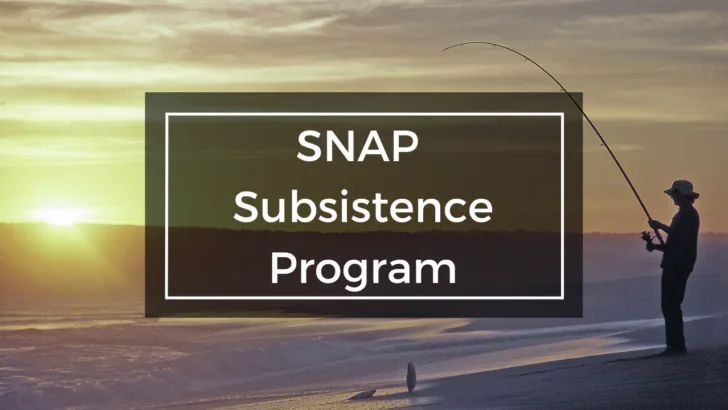Eligible Alaskans who receive Supplemental Nutrition Assistance Program benefits may be able to purchase hunting or fishing gear with their EBT benefits!
What is the SNAP Subsistence Program?
The SNAP Subsistence Program is a variation of the Supplemental Nutrition Assistance Program that serves rural Alaskans who have limited access to traditional retail grocery stores.
In many parts of rural Alaska, residents rely on hunting or fishing to provide the majority of their food. An eligible person who cannot access a grocery store can instead using their benefits to purchase eligible hunting and fishing equipment.
Who is eligible for this program?
In order to be eligible for the SNAP Subsistence Program, you must meet several requirements.
You must meet SNAP requirements.
First, you must meet the requirements for the Supplemental Nutrition Assistance Program in Alaska. These requirements include income and asset limits.
Your income cannot exceed 130% of the current Alaska poverty standard. The Alaska poverty standard is different than the Federal Poverty Level for the 48 contiguous states. In 2023, the Alaska poverty limit is $37,500 for a family of four so 130% of that would be $48,750 for a family of four. The level may vary depending on what region of Alaska you live in.
You must live in an eligible area.
Not every Alaskan can purchase hunting and fishing gear with their SNAP benefits. In order to use this special Subsistence program, you must live in an area that has limited access to retail stores according to the state’s determination.
Eligibility is determined by whether or not a town has access to grocery stores or transportation via paved roads, ferries or trains. Cities like Anchorage and Juneau are understandably disqualified, but small villages like Tancross and Kake because they have access to road and ferry systems.
Due to the size of the state, it’s easier to list the places that do have access to grocery stores. That’s why most of the state literature lists places that are NOT eligible instead of places that are.
In Central Alaska, the following areas are disqualified from this program because they have sufficient access to retail stores:
- Anchorage
- Big Lake
- Chugiak
- Eagle River
- Girdwood
- Houston
- Mt. View
- Palmer
- Spenard
- Sutton
- Talkeetna
- Wasilla
- Willow
In Coastal Alaska, the areas NOT eligible for this program include:
- Anchor Point
- Cordova
- Homer
- Glennallen
- Kenai
- Kodiak
- Moose Pass
- Ninilchik
- Seldovia
- Seward
- Soldotna
- Valdez
In Northern Alaska, the areas that do NOT qualify for this program are:
- Big Delta
- College
- Dot Lake
- Fairbanks
- Nenana
- Northway
- North Pole
- Tanacross
- Tok
Finally, the Southeast Alaska areas that do NOT qualify for these special SNAP rules are:
- Craig
- Haines
- Hollis
- Hoonah
- Juneau
- Kake
- Ketchikan
- Klawock
- Metlakatla
- Petersburg
- Sitka
- Skagway
- Douglas
- Auke Bay
If you live in an area that is not listed here, then you may be eligible for the SNAP Subsistence Program.
You must rely on subsistence for the majority of your food.
The final requirement for the SNAP Subsistence Program is that you must rely “substantially” on hunting and fishing for your food. If you live in a rural area without much access to grocery stores, this should be a given.
However, you have to prove your reliance by providing a subsistence statement as described below.
How do you apply for the SNAP Subsistence Program?
If you want to use your Supplemental Nutrition Assistance Program benefits to purchase hunting and fishing gear in Alaska, then you must submit a subsistence statement with your SNAP application.
The subsistence statement must be written by the head of the household, their spouse or authorized representative. No other person in the household can prepare or submit this statement.
The statement must include several key phrases. If you do not include these, your statement may not be sufficient and it may be rejected.
- You must state that you intend to get the majority of the food for your household through gathering, hunting and fishing.
- You must state that your household will not use the items purchased with SNAP for commercial purposes.
Once you’ve written a brief statement that includes both of these phrases, then you can submit that with your SNAP application.
How does the SNAP Subsistence Program work?
Eligible households will receive a special SNAP Identification Card that proves you are eligible to use your food benefits to purchase hunting and fishing gear. You will need to present this special identification card in order to purchase your equipment with those benefits.
With that card, you can purchase any items that are necessary for attaining food. This includes:
- Fishing rods
- Harpoons
- Hooks
- Ice augers
- Knives
- Nets
- Lines
However, this is not an extensive list. According to the United States Department of Agriculture, some items that are not expressly mentioned in the Act are eligible for purchase.
While bait for fishing is not specifically mentioned in the Act or in regulation, it is considered “other equipment necessary for subsistence” and may be purchased with SNAP benefits by those with a specially-marked card.
ask.usda.gov
Unfortunately, you cannot purchase any closely related items that are not necessary to attain food. For example, you cannot purchase clothing, shelter, or transportation items like gasoline or camouflage.
You also cannot purchase firearms, ammunition, or explosives with SNAP benefits.
Is this program helpful?
Although up to 95% of rural Alaskans depend on subsistence for food, studies show that less than 7% of eligible Alaskans actually use this benefit according to Anchorage News Daily. This program has been in operation since at least 1983.

